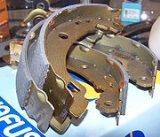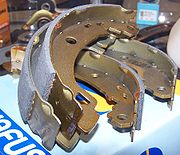
Brake shoe
Encyclopedia

Brake lining
Brake linings are the consumable surfaces in brake systems, such as drum brakes and disc brakes used in transport vehicles.-History:Brake linings were invented by Bertha Benz during her historic first long distance car trip in the world in August 1888.-Structure and function:Brake linings are...
in the drum brake
Drum brake
A drum brake is a brake in which the friction is caused by a set of shoes or pads that press against a rotating drum-shaped part called a brake drum....
s used on automobile
Automobile
An automobile, autocar, motor car or car is a wheeled motor vehicle used for transporting passengers, which also carries its own engine or motor...
s, or the brake block in train
Brake (railway)
Brakes are used on the cars of railway trains to enable deceleration, control acceleration or to keep them standing when parked. While the basic principle is familiar from road vehicle usage, operational features are more complex because of the need to control multiple linked carriages and to be...
brakes and bicycle brakes.
Automobile drum brake
The brake shoe carries the brake lining, which is rivetRivet
A rivet is a permanent mechanical fastener. Before being installed a rivet consists of a smooth cylindrical shaft with a head on one end. The end opposite the head is called the buck-tail. On installation the rivet is placed in a punched or pre-drilled hole, and the tail is upset, or bucked A rivet...
ed or glued to the shoe. When the brake is applied, the shoe moves and presses the lining against the inside of the drum. The friction
Friction
Friction is the force resisting the relative motion of solid surfaces, fluid layers, and/or material elements sliding against each other. There are several types of friction:...
between lining and drum provides the braking effort. Energy is dissipated as heat.
Modern cars have disc brake
Disc brake
The disc brake or disk brake is a device for slowing or stopping the rotation of a wheel while it is in motion.A brake disc is usually made of cast iron, but may in some cases be made of composites such as reinforced carbon–carbon or ceramic matrix composites. This is connected to the wheel and/or...
s all round, or discs at the front and drums at the rear. An advantage of discs is that they can dissipate heat more quickly than drums so there is less risk of overheating.
The reason for retaining drums at the rear is that a drum is more effective than a disc as a parking brake.
Railway tread brake
The brake shoe carries the brake block. The block was originally made of wood but is now usually cast ironCast iron
Cast iron is derived from pig iron, and while it usually refers to gray iron, it also identifies a large group of ferrous alloys which solidify with a eutectic. The color of a fractured surface can be used to identify an alloy. White cast iron is named after its white surface when fractured, due...
. When the brake is applied, the shoe moves and presses the block against the tread of the wheel. As well as providing braking effort this also "scrubs" the wheel and keeps it clean. Tread brakes on passenger trains have now largely been superseded by disc brake
Disc brake
The disc brake or disk brake is a device for slowing or stopping the rotation of a wheel while it is in motion.A brake disc is usually made of cast iron, but may in some cases be made of composites such as reinforced carbon–carbon or ceramic matrix composites. This is connected to the wheel and/or...
s.
Bicycle rim brake
This comprises a pair of rectangular open boxes which are mounted on the brake calipers of a bicycleBicycle
A bicycle, also known as a bike, pushbike or cycle, is a human-powered, pedal-driven, single-track vehicle, having two wheels attached to a frame, one behind the other. A person who rides a bicycle is called a cyclist, or bicyclist....
and that hold the brake blocks which rub on the rim of a bicycle wheel to slow the bicycle down or stop it.
Cataloguing
There are different systems for the cataloguing of brake shoes. The most frequently used system in Europe is the WVA numbering systemWVA number
WVA numbers are a reference and assignment system for brake linings, clutch facings, brake shoes and other friction materials which will especially be used in road vehicles but also in mechanical engineering. The WVA numbering system has been developed by the "VRI-Verband der Reibbelagindustrie" ,...
.

